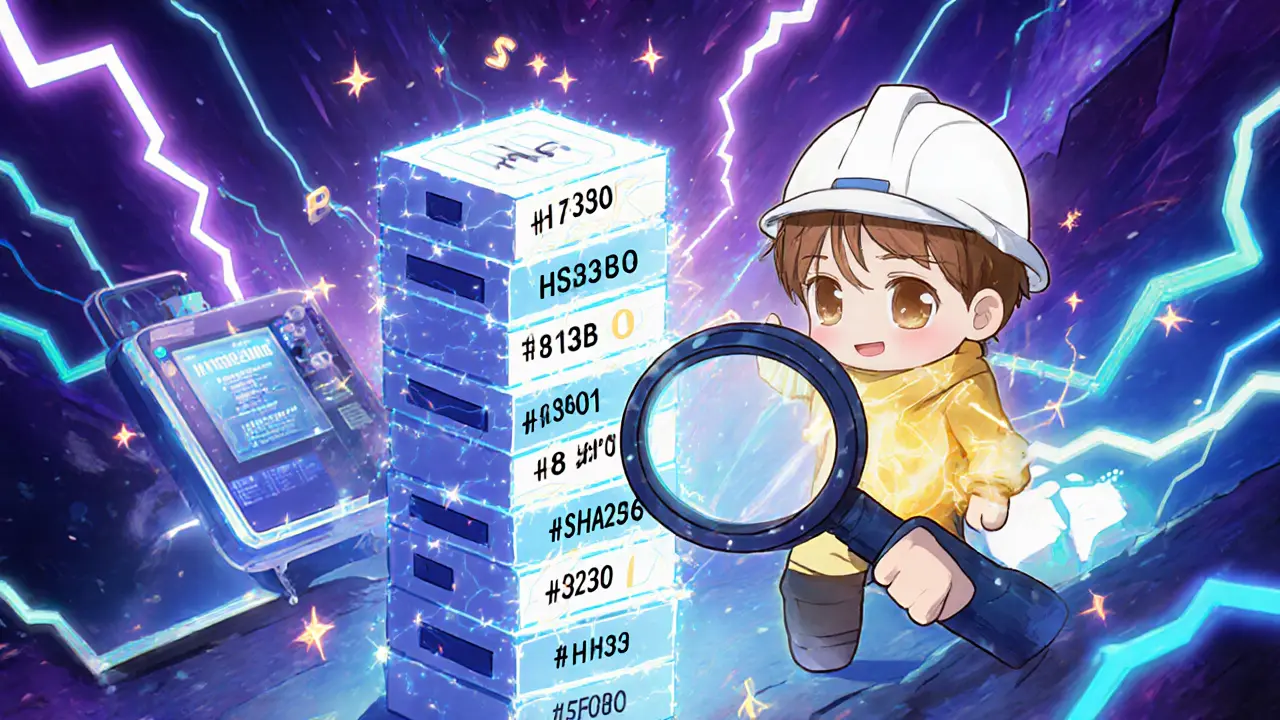Bitcoin Block Structure Explorer
A Bitcoin block consists of a fixed-size header (80 bytes) and a variable-length transaction list. This tool breaks down the components of a block header to help you understand how they work together.
Contains metadata and cryptographic hashes required for mining and linking blocks.
- Version 4 bytes
- Previous Block Hash 32 bytes
- Merkle Root 32 bytes
- Timestamp 4 bytes
- nBits (Difficulty Target) 4 bytes
- Nonce 4 bytes
Contains a list of transactions moving satoshis between addresses.
- Transaction Count (compact-size encoded)
- Each Transaction:
- Version (4 bytes)
- Inputs (references to UTXOs)
- Outputs (new UTXOs with values and locking scripts)
- Locktime (optional)
- Witness Data (in SegWit blocks)
Block 1 (first block after genesis) has these fixed header values:
- Version: 0x01000000
- Previous Block Hash: 6fe28c0a...00000000
- Merkle Root: 982051fd...233e0e
- Timestamp: 0x61bc6649
- nBits: 0xffff001d
- Nonce: 0x01e36299
These exact bytes follow the same layout today.
- Block header never changes once accepted
- Any transaction change affects Merkle root
- Mining iterates nonce until valid hash found
- SegWit separates witness data from block weight
- Gather transactions from mempool
- Construct candidate block
- Iterate nonce until valid hash found
- Broadcast winning block
Tip:
Use blockchain explorers to inspect real block data. They show headers, transaction counts, Merkle roots, and detailed transaction information.
If you’ve ever stared at a blockchain explorer and wondered what the jumble of hex actually means, you’re not alone. The Bitcoin block structure is the backbone of the whole network, and getting a grip on it unlocks everything from mining to developing wallets.
What a Bitcoin block actually is
Think of a Bitcoin block as a digital page in an ever‑growing ledger. Each page holds a bundle of transactionsrecords that move Bitcoin from one address to another and a cryptographic seal that ties it to the previous page. The seal is created by hashing the block’s header, so any change to a single transaction ripples through the entire chain.
Two‑part anatomy: header + transaction list
The block splits cleanly into two sections:
- Block headerAn 80‑byte package containing metadata and cryptographic hashes that miners repeatedly hash
- Transaction section - a compact‑size encoded count followed by each transactionThe basic unit that moves satoshis, carries scripts, and may contain witness data
Because the header never changes once the block is accepted, it becomes the immutable anchor for the whole blockchain.
Inside the 80‑byte block header
Every miner assembles these six fields, serializes them, and runs double‑SHA256 until the resulting hash is lower than the current difficulty target. The layout is fixed, which makes parsing simple for any node implementation.
| Field | Size (bytes) | Description |
|---|---|---|
| Version | 4 | Indicates which set of validation rules the block follows; enables soft‑fork upgrades. |
| Previous block hash | 32 | SHA256(SHA256()) of the prior block’s header, linking blocks cryptographically. |
| Merkle root | 32 | Hash of all transaction IDs in the block; any transaction alteration changes this root. |
| Timestamp | 4 | Unix epoch time when the miner started hashing; must be > median of last 11 blocks and < 2hours in the future. |
| nBits (difficulty target) | 4 | Compact representation of the target threshold; defines how hard it is to find a valid hash. |
| Nonce | 4 | Arbitrary 32‑bit number that miners increment to change the header hash. |
Take Block 1 (the first block after the genesis) as a concrete example: its version is 0x01000000, previous hash is 6fe28c0a…00000000, Merkle root is 982051fd…233e0e, timestamp 0x61bc6649, nBits 0xffff001d, and nonce 0x01e36299. Those exact bytes still follow the same layout today.
Transaction section - from inputs to outputs
After the header, the block stores a transaction countEncoded as a variable‑length integer that tells how many transactions follow. Each transaction is built from four parts:
- Version - 4bytes, lets the protocol evolve.
- Inputs - each references a previous UTXOUnspent Transaction Output that can be spent in a new transaction via its transaction ID and output index.
- Outputs - define new UTXOs, each with a value in satoshis and a locking script (usually a
pubkeyhash). - Locktime - optional field that makes the transaction valid only after a certain block height or timestamp.
When SegWit is enabled, a marker byte (0x00) and a flag byte (0x01 or greater) appear before the inputs, and the witness data (signatures, scripts) follows the outputs. This design keeps legacy nodes happy while giving extra space for signatures.

SegWit, Taproot and other extensions
SegWit (Segregated Witness) arrived in 2017 and moved the signature data out of the traditional input structure. In the block header the size remains 80bytes, but the block’s effective capacity grows because witness data is counted in a separate weight metric. TaprootA 2021 soft‑fork that bundles multiple spending conditions into a single public key, improving privacy and efficiency builds on SegWit, allowing complex scripts without revealing them on‑chain unless used.
Both upgrades keep the core header untouched, which is why developers can rely on the same parsing logic even as the transaction format evolves.
How mining turns a candidate block into a real block
Mining is essentially a trial‑and‑error search:
- Gather pending transactions from the mempool.
- Construct a candidate block: set version, previous hash, compute the Merkle root, add a timestamp, and pick the current nBits.
- Iterate the nonce (and sometimes extra nonce bytes in the coinbase transaction) until the double‑SHA256 of the header is below the target.
- Broadcast the winning block; peers re‑hash the header to verify the proof‑of‑work, then validate each transaction against consensus rules.
Inspecting blocks with a blockchain explorer
Anyone can paste a block hash or height into a blockchain explorerWeb interface that parses and displays raw block data in a human‑readable format. The UI typically shows the header fields, transaction count, Merkle root, and a list of each transaction with input and output details. For developers, most explorers offer an API endpoint that returns the same JSON structure used by full nodes.
Practical tips and common pitfalls
- Don’t trust the timestamp blindly. Miners can shift it within the allowed two‑hour window, so use median‑time‑past for security‑critical logic.
- When parsing the Merkle root, remember byte order. Internally Bitcoin stores hashes in little‑endian; most UI tools flip them to big‑endian for readability.
- Watch out for transaction malleability. Before SegWit, a transaction’s ID could change after signing, breaking dependent protocols. SegWit solved this, but legacy tools still need special handling.
- Validate the nBits field. It’s a compact representation; converting it to the full target requires a bit of bit‑shifting math.
Getting these details right is the difference between a buggy wallet and a reliable one.
Quick recap of the most important points
- A Bitcoin block = 80‑byte header + variable‑length transaction list.
- Header fields: version, previous hash, Merkle root, timestamp, nBits, nonce.
- Transactions reference UTXOs, create new UTXOs, and may include SegWit witness data.
- Mining is a hash‑puzzle on the header; a valid block links cryptographically to its predecessor.
- Explorers and APIs let anyone view the raw structure, useful for debugging and analysis.

Frequently Asked Questions
What does the Merkle root prove?
The Merkle root is a single hash that uniquely represents every transaction in the block. If any transaction changes, the root changes, which in turn changes the block header hash. This makes it impossible to tamper with a single transaction without re‑mining all subsequent blocks.
Why is the block header always 80bytes?
The 80‑byte size is hard‑coded into the Bitcoin protocol. Keeping it constant simplifies the proof‑of‑work algorithm and ensures all nodes can validate blocks quickly, regardless of how many transactions are inside.
How does SegWit affect block size?
SegWit separates signature data (witness) from the main block weight. The original 1MB limit still applies to the non‑witness part, but the total block weight can reach 4MB, effectively increasing capacity without changing the header.
Can I change a block’s timestamp after it’s mined?
No. Once the block is accepted, its header-including the timestamp-is immutable. Any attempt to alter it would break the hash link to the next block and be rejected by the network.
What role does the ‘nonce’ play in mining?
The nonce is a 32‑bit counter that miners vary to produce a new header hash each trial. Adjusting the nonce changes the hash output; the goal is to find a nonce that yields a hash lower than the current difficulty target.




Patrick MANCLIÈRE
October 5, 2025 AT 09:14When you look at the 80‑byte header, start with the version field – it tells the network which consensus rules apply. The previous‑block hash links this block cryptographically to its predecessor, forming the immutable chain. Next comes the Merkle root, a single hash that summarises every transaction in the block; any tweak to a transaction flips the root. The timestamp is a Unix epoch time, constrained to be greater than the median of the last eleven blocks and not more than two hours in the future. nBits encodes the current difficulty target in a compact form, and finally the nonce is the 32‑bit counter miners crank through to solve the proof‑of‑work. Understanding each piece makes parsing raw block data a breeze.
Lurline Wiese
October 6, 2025 AT 00:33OMG, the way the guide breaks down each header field feels like someone finally gave us the cheat‑sheet we’ve been begging for – crisp, clear, and no fluff. The Merkle root section especially hits the sweet spot: you can actually visualise how a single transaction ripples through the whole block. And those little hex examples? Pure gold for anyone tinkering with raw block bytes.
Scott McReynolds
October 6, 2025 AT 17:13The Bitcoin block is more than a technical construct; it is the very pulse of a decentralized financial organism, and every byte reverberates with economic intent. By dissecting the header, we uncover a blueprint that has resisted half‑a‑century of adversarial attacks, proving that simplicity can coexist with robustness. The version field, while ostensibly trivial, acts as a signaling mechanism for soft‑fork upgrades, allowing the ecosystem to evolve without fracturing. The previous‑block hash is the immutable tether that stitches each block into an unbreakable chain, ensuring that tampering with history would require rewriting every subsequent block – an astronomically prohibitive task. The Merkle root, a single hash derived from a binary tree of transaction IDs, offers a compact proof that every transaction belongs to the block, enabling lightweight clients to verify inclusion without downloading the full ledger. Timestamps, though often dismissed as mere metadata, provide a temporal anchor that guards against time‑warp attacks, and the median‑time‑past rule tempers miner manipulation. nBits encodes the difficulty target in a compact format, translating the network’s collective computational power into an adjustable hurdle that stabilises block intervals around ten minutes. The nonce, the humble 32‑bit counter, becomes the arena where miners wage a probabilistic war, iterating through billions of possibilities to find a hash beneath the target. SegWit’s introduction of witness data reshaped block weight calculations, separating signature data from the core 1 MB limit and effectively expanding capacity while preserving backward compatibility. Taproot later built upon this foundation, allowing complex scripts to masquerade as simple single‑key spends unless revealed, enhancing privacy and efficiency. Mining, at its heart, is a dance between hash functions and economic incentives, rewarding the first participant to solve the puzzle with newly minted bitcoins and transaction fees. The reward schedule, halving every 210,000 blocks, embeds scarcity into the protocol, echoing monetary policy principles. Moreover, the deterministic nature of block propagation ensures that once a block is accepted, its header and all contained transactions are immutable, fostering trust among participants. Tools like blockchain explorers democratise access to this data, turning opaque hex strings into readable tables that developers and analysts can query via APIs. Finally, mastering block structure equips you to audit wallet implementations, debug consensus errors, and appreciate the elegant engineering that underpins a global, trustless ledger.
Kortney Williams
October 7, 2025 AT 09:53Accurate parsing of byte order is essential to avoid subtle bugs.
Adarsh Menon
October 8, 2025 AT 02:33Yeah, because after reading a few hex dumps we’ll all become overnight blockchain wizards, right?
stephanie lauman
October 8, 2025 AT 19:13The guide glosses over the fact that nBits representation is rife with corner‑case ambiguities, which can be exploited to manipulate difficulty calculations under certain network conditions.
Laurie Kathiari
October 9, 2025 AT 11:53While it’s true that the compact‑encoding of nBits can be confusing, most full nodes enforce strict validation, so the risk is largely theoretical for honest miners.
Matt Nguyen
October 10, 2025 AT 04:33One must also consider the epistemological implications of treating the block header as a purely technical artifact, when in reality it encapsulates a sociotechnical contract among decentralized actors.
Amal Al.
October 10, 2025 AT 21:13Indeed, recognizing the header as a manifestation of collective trust helps us design better educational resources that bridge theory and practice for newcomers.
Kimberly Kempken
October 11, 2025 AT 13:53The whole obsession with block size is a diversion; the real bottleneck is the latency of peer‑to‑peer propagation, not how many transactions we squeeze into a 1 MB window.
Twinkle Shop
October 12, 2025 AT 06:33From a network‑layer perspective, throughput is constrained by the gossip protocol’s bandwidth ceiling and the variance in node connectivity, which mandates a reevaluation of protocol‑level optimisations beyond mere block‑size increments.
Carthach Ó Maonaigh
October 12, 2025 AT 23:13Yo, if we don’t fix the gossip churn, we’ll just keep stacking txs in a bigger blob that no one can actually share fast enough.
Rob Watts
October 13, 2025 AT 15:53Propagation delay often eclipses raw block capacity in real‑world deployments.
Greer Pitts
October 14, 2025 AT 08:33That’s why many developers prioritize relay‑network upgrades and compact block relay to shave milliseconds off each hop, improving overall network health.
Jenise Williams-Green
October 15, 2025 AT 01:13We must hold the community accountable for neglecting these optimizations, lest we betray the very principles of decentralisation and fairness that Bitcoin was founded upon.